Specialist
In January 1847 Dr William Jones, who had discerned a lack of an institution specially for the treatment of diseases of the womb, founded the charitable Gynaepathic Institute, with 8 beds, in Gray Street, Manchester Square. Despite this name, for the first three years of its existence, the Hospital also treated men as out-patients, as well as women and children as in-patients. Not all female patients were suffering from gynaecological conditions. In the first six months of opening the Institute treated 306 women, of whom only 105 (34.31%) had diseases 'peculiar to their sex'. The others sought treatment for afflictions such as influenza, rheumatism, quinsy and chronic ulcers.
Shortly after it opened, in March 1847 the Institute moved to 7 North Audley Street, at a yearly rent of £50, sharing the premises with a 'medical gentleman', who rented the lower part and who undertook to act as its surgeon and dispenser.
On 7th February 1848 it was renamed the Free Hospital for Women and Children and Samaritan Institution, the governing Committee's attempts to restrict treatment to women and children having succeeded.
In March 1850 it moved again, this time to a 10-roomed house at 27 Orchard Street as the Free Hospital for Women and Children. It had 8 beds and a room for the Matron.
In 1854, at the instigation of the rector of St Mary's parish church, Revd. J. Hampden Gurney, the Hospital merged with the Marylebone Dispensary in George Street. (A year later Revd. Gurney suggested that it amalgamate with the Queen Charlotte's Lying-In Hospital in Marylebone Road, but this advice was not heeded.)
The surgeon for the Marylebone Dispensary, Thomas Spencer Wells (1818-1897), was elected to the staff of the Free Hospital (the incumbent surgeon to the Hospital later resigned).
In 1858 the Hospital moved to Lower Seymour Street, Portman Square. In an outbreak of vulgarity, the Committee erected a large sign, indicating the functions of the Hospital. The white boards with foot-high black letters were hung on the front of the building from the garret to the basement, with scarcely an inch of wall to be seen.
Gynaecological disease at this time was usually the province of the physicians, not the surgeons, but it was here in 1858 that one of the first ovariotomies (removal of the ovary) was performed by Spencer Wells; his mortality rate later proved to be one-third of the average of other London hospitals. Spencer Wells was also successful in performing hysterectomies (removal of the womb), an operation so universally fatal that most surgeons refused to undertake it (at this time there was no antisepsis or anaesthesia).
In 1862 the Hospital had 50 beds. In 1863 Spencer Wells decided that all operations at the Hospital, apart from uterine cases, should be performed only by surgeons. (It was not until 1904 that physicians were allowed to open the abdomen. By 1907 all had to have obtained the Fellowship of the Royal College of Surgeons.)
In 1869 it became the first free hospital to provide pay-beds for patients of limited means, but who could contribute between one to three-and-a-half guineas (£1.05-£3.15) towards the costs of their hospitalisation. There were 23 such beds. During this time in the 19th century, those who could afford medical and surgical treatment typically were attended to in their own homes; hospitals were the preserve of poor people, who received free treatment, and therefore admission to one carried a stigma.
In 1874 the Hospital opened a branch at 1, Dorset Street, Manchester Square, in a house previously occupied by the celebrated mathematician, Charles Babbage (1791-1871). The new branch became the children's in-patient department, and also treated medical gynaecological disorders, while the Lower Seymour Street premises only admitted patients for ovariotomy.
From 1884 the children's ward became underused, and this was explained by the competition from Paddington Green Children's Hospital, which had opened in 1883. It was decided to close the ward in 1888.
On 24th July 1889 the Prince of Wales,
accompanied by the Princess of Wales and Princess Maud and Victoria,
laid the memorial stone for a new Hospital building on land in
Marylebone Road that it had purchased three years earlier for
£17,000. As the lease on the Dorset Street premises expired that
year, Lord Portman gave Nos. 232-234 Marylebone Road for use
until
the new premises were ready. The Hospital moved to its
purpose-built red brick and terracotta building in October 1889.
The new Hospital had 88 beds in two sections; the surgical side
with 11 wards of two beds each and 3 larger convalescent wards, and the
medical side with 5 wards and a smaller one used as a theatre.
On his
death in October 1890 the Scottish engineer James
Nasmyth (1808-1890) bequeathed £14,000, thus
settling the £12,000 still to be paid on the new building.
The Hospital named a ward after him.
In 1903 children ceased to be treated and in 1904 the Hospital was renamed the Samaritan Free Hospital for Women. In its 57th year it had finally become a dedicated gynaecological hospital, specializing in surgery, which was carried out in a single room devoid of all fittings and constantly sprayed with carbolic (there was no operating theatre).
On 17th June 1905 a new building for the Out-Patients Department, with a Nurses' Home above, was opened by the President of the Hospital, Lord Leigh. The site in Walmer Street, Seymour Place (immediately behind the Hospital), had been targetted for a long time but the Hospital had had to wait until the existing lease fell in so that it could buy it. The walls of the new Department were tiled in lemon yellow and white; the windows and skylights were glazed with ground glass. The patients would enter in one door, collect their cards, enter the waiting room until they were called to the consulting room, and then hence to the dispensary to collect their medication, finally exiting through another door.
In 1908 an operating theatre was installed on the top floor and opened on 23rd November by Sir Frederick Treves(1853-1923), surgeon to the London Hospital. (Previously, general operating theatres had not been trusted for ovariotomy cases and the operation was carried out instead in a small dedicated room. A single nurse was then assigned for the duration of some weeks to care for the patient post-operatively.)
By the beginning of the 20th century the Samaritan Free Hospital, despite its small size, had become one of the country's most important gynaecological hospitals.
On 28th February 1912 a new Nurses' Home to the west of the main building was opened by Viscountess Portman. On 16th April two rooms on the ground floor of the Hospital, which had been used as a sitting room for Matron and the nurses, was converted into a new ward.
During WW1, due to a shortage of male doctors, the Hospital appointed its first females to the medical staff.
On 9th March 1915 an adjacent house at No. 173 Marylebone Road was purchased for £2,500.
In 1916 the Hospital Committee rented Brickwick, a house in Coleshill, near Amersham, for use as a convalescent home. After the war, in 1919 the Committee bought Wallers Oak, a house in the same hamlet, as a permanent convalescent home.
On 10th October 1917 the Hospital received slight damage from an air-raid.
In November 1934 a new extension was opened by Lord Moynihan (1865-1936). It contained a general ward, as well as 14 rooms for private patients and accommodation for 24 nurses. It had cost £27,000, of which £5,000 still had to be raised. Plans were proposed to open a Radiotherapy Department as soon as the funds became available; an extra storey would be added to the new building to house it.
During WW2 the Hospital joined the Emergency Medical Service with 103 beds.
In 1946 the Hospital again had 88 beds. The weekly cost of an in-patient was £7 0s 5d (£7.02).
In 1947 the interior of the Hospital was redecorated but, instead of the depressing greens and browns so common in hospitals, the walls were painted cream and the dado a light blue-green.
A Parenthood Clinic was established to help childless couples.
In 1948 the Hospital joined the NHS, becoming affiliated to St Mary's Hospital. It was renamed the Samaritan Hospital for Women.
In 1982 it had 79 beds. In 1987 the Hospital building was listed by English Heritage as Grade II.
The Hospital closed in 1997.
Present status (December 2009)
The Hospital building in Marylebone Road remains empty.
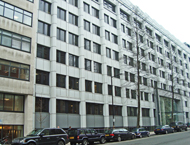
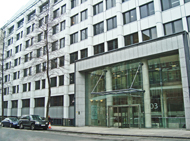
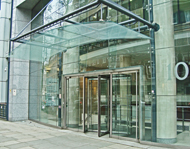
Lower Seymour Street later became part of Wigmore Street. The site of the Hospital would have been where the east wing of Nations House, a modern multi-tenanted office development at 103 Wigmore Street, has been built.
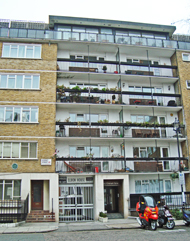
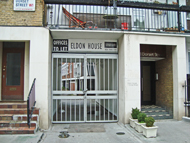
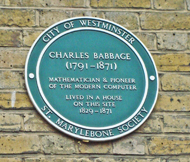
Nothing remains of the original 1 Dorset Street. 1A Dorset Street bears a commemorative plaque to Charles Babbage, whereas 1B is Eldon House, containing apartments and rented offices.
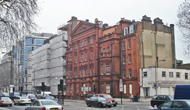
The Hospital building in Marylebone Road, photographed in February 2008, shows the neighbouring Western Eye Hospital covered in bandages on the left, undergoing refurbishment.
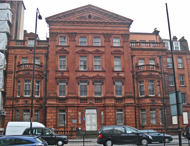
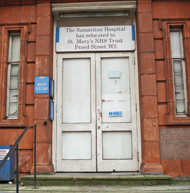
The Marylebone Road building remains vacant, a notice posted on the entrance door advising patients that the Hospital is closed.
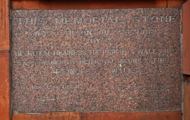
The cornerstone commemorating the official opening of the Marylebone Road Hospital by the Prince of Wales, accompanied by the Princess of Wales, in 1889.
(surgical removal of the ovary)
During the 19th century, ovariotomy (oophorectomy) was performed for ovarian disease, particularly cysts and dropsy.
The first ovariotomy had been performed in 1809 by an American surgeon in Kentucky, Ephraim McDowell (1771-1850), without anaesthesia (the patient distracted herself by singing hymns throughout the procedure) or antisepsis. He removed a 20 lb (9 kilos) tumour and the patient survived, living for more than 30 years after the operation.
The case was written up and published, but the concept of the procedure was met with disbelief and disgust by the British medical profession. It was not until 1824 that the first ovariotomy was performed in Britain by John Lizars (1787-1860) on a woman who was proven to have been misdiagnosed - she was simply obese.
The operation fell out of favour until revived by Thomas Spencer Wells, surgeon to the Samaritan Free Hospital. He had performed his first ovariotomy in 1857 and his second, at the Samaritan, in February the following year.
'Cleanliness' and cold water (previously boiled) were the only measures used to prevent sepsis. (Each year the wards were closed for a number of weeks, usually in August or September, to allow thorough cleaning of the entire building.) Post-operative care consisted of beef tea, arrowroot and brandy being administered every 10-15 minutes during the first few days. On the eighth day this was supplemented by fish and a light pudding. After two weeks more substantial meals, including meat, were allowed.
In 1867 the mortality rate from the operation of Spencer Wells' patients was 28.30%, which compared favourably with that of Guy's Hospital (47.73%) and of St Bartholomew's Hospital, the Middlesex Hospital, King's College Hospital and University College Hospital (76.92%).
When Listerian antiseptic procedures were introduced at the Samaritan in 1876, the mortality rate fell to 12.89%.
(Author unstated) 1961 The first ovariotomy. Irish Journal of Medical Science 36 (Suppl 3), 513-514.
www.medicaldiscoverynews.com
(Author unstated) 1905 The Samaritan Free Hospital. British Journal of Nursing, June 17, p. 479.
(Author unstated) 1907 Samaritan Free Hospital. British Medical Journal 2, 1595-1596.
(Author unstated) 1934 Opening of Samaritan Free Hospital extension. British Medical Journal 2, 912.
Brown K 1992 Tales from the Archives. Spencer Wells at the Samaritan. St Mary's Gazette 98, 28-30.
Fraser A 1997 The Samaritan Free Hospital for Women, Marylebone Road, London. St Mary's Gazette 103, 33-34.
Jones S 2000 The Samaritan Hospital, 1847-1907: Man's Hospital for Women. (Unpublished dissertation, filed at the Wellcome Library).
Oxford AW 1931 The History of the Samaritan Free Hospital, with an Appendix on the London Hospitals and Infirmaries. Cambridge, W Heffer & Sons.
Siddall-Allum J 1993 The early days of the Samaritan. St Mary's Gazette 99, 21-22.
Weinreb B, Hibbert C (eds) 1983 London Encyclopedia. London, Macmillan.
http://hansard.millbanksystems.com
www.britishlistedbuidlings.co.uk
www.flickr.com
www.pastscape.org.uk
www.victorianlondon.org
Return to home page